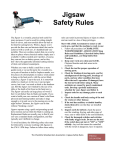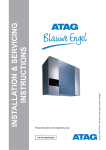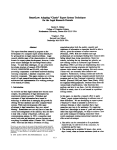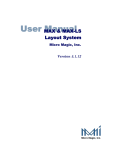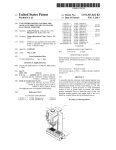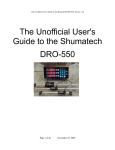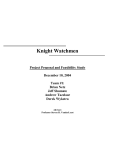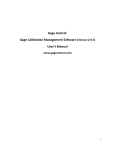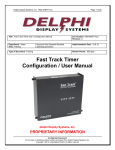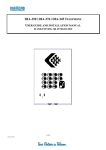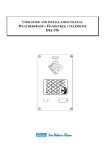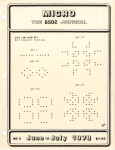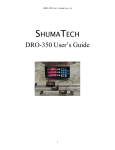Download Jitter Bug - Watch your Shumatech DRO display dance
Transcript
Jitter Bug - Watch your Shumatech DRO display dance By Lawrence W. Gill and R. G. Sparber Version 5 July 15, 2007 Copyleft protects this article. Conclusion With a careful choice of filter values, you can eliminate almost all of your caliper jitter and not degrade your Shumatech DRO’s accuracy. Overview This article discusses the basics of trying to use digital means to measure movement. Jitter is a natural result. Means are suggested to minimize this side effect and their consequences discussed. A design choice that we consider a minor software bug is explained and a work-around offered. The impact of this bug on system accuracy and repeatability is presented. Various sets of data are offered which were derived from using the quieted Shumatech DRO. Table of Contents CONCLUSION .............................................................................................................................................. 1 OVERVIEW ................................................................................................................................................. 1 TABLE OF CONTENTS ................................................................................................................................. 1 "WHAT WE HAVE HERE IS A FAILURE TO COMMUNICATE" .......................................................................... 2 OUR ANALOG WORLD COLLIDES WITH OUR DIGITAL WORLD .................................................................. 2 WHY CAN'T YOU MAKE UP YOUR MIND?..................................................................................................... 4 THE THREE BEARS STORY ......................................................................................................................... 9 The Filter Value Section Procedure .................................................................................................. 10 THE 5 TENTHS INDICATOR FLICKER......................................................................................................... 10 THE ROUND OFF ERROR BUG ................................................................................................................... 13 ACCURACY VERSUS REPEATABILITY ....................................................................................................... 16 REAL DATA.............................................................................................................................................. 22 Setting Expectations........................................................................................................................... 22 Overview of the Data ......................................................................................................................... 23 A close up View.................................................................................................................................. 23 A View Over a Larger Range............................................................................................................. 24 Absolute Accuracy ............................................................................................................................. 25 Repeatability...................................................................................................................................... 26 MATCHING THE PROCEDURE TO THE DESIRED ACCURACY ...................................................................... 27 Page 1 "What we have here is a failure to communicate" We authors have traded many emails related to reducing jitter in our Shumatech DROs. It took a long time for use to realize that some of the jitter that was tormenting us was just an artifact of having a digital system. In the end we decided to write one article on jitter that is natural to a digital system and a second article that will deal with means we have found to reduce jitter due to unnecessary noise. This article assumes that you are starting with a "clean" system. With a filter value of 0 and the DRO set to 0, there is no jitter of the 5 tenths indicator. The sign indicator will jitter. Our Analog World Collides with our Digital World Don't panic - we will attempt to explain these odd terms. Consider the incredible accuracy of my placement of point "A" relative to the left end of the line. No matter what you use to measure point A's position, it will never be as accurate as the above picture. That is because this point is marked on a continuous line. This is analog. Where exactly is point A? It is right where I drew it. The problem illustrated here is that we have no perfect numerical way to represent this distance. We live in "analog space" but the world of measurement is "digital space". By this we mean that we represent an exact distance in analog space with a number. If we look close enough, there will always be error in this conversion. It is only when we consider how the measurement will be used can we determine if it is good enough. Page 2 For example, I can measure this line with my tape measure and read 1½" ± 1 /8". Within the limitations of that tape measure and my ability to use it accurately, this might be a usable number in framing a house. I can then pull out my Harbor Freight® digital caliper and read 1.490" ±0.001". Again, given the limitations of the caliper and my ability to use it accurately, this might be fine if I am making a bracket while the tape measure reading is too sloppy for a good fit. I could even trot my precious line and point down to the National Bureau of Standards. They might tell me the distance is 1.489369" ±0.000001". I will not question their equipment or abilities. Even in the case of the NBS reading, I might have an application where I need one more digit of accuracy. The fact is all measurements are an approximation. With that in mind, take a closer look at an ideal "Chinese Caliper". The nonideal ones can be bought for under $17 at Harbor Freight. An ideal caliper breaks each inch into exactly 20,480 discrete points. Note that each of these points is assigned an integer. So, for example, we can talk about a point at 2 or 3 but never at 2.4. In the analog work, there is a point at 2.4 but when the caliper converts this point to a digital approximation, it finds that 2 is the closest value. In this greatly magnified view of our ideal caliper, the distance between tick marks is 1/20,480 = 0.00004883" when shown to 8 places. Compare that to the advertised accuracy of ± 0.001". This says that the caliper can generate a number internally where a single increment ideally represents ±0.00004883" yet have an accuracy that is 23 times that number (±0.00004883" x 23 counts = ±0.001"). Page 3 The manufacturer also advertises a repeatability of 0.0005". The caliper can either have the 5 visible or off. When lit, it says we are at a position that ends in 5 tenths even though the entire number is only accurate to ±0.001". This can generate confusion when we talk about repeatability versus accuracy. What they are saying is that I can have any number as long as it is limited to ending in either 0 or 5 tenths. That number is within ±0.001" of the true value. For example, I can read 0.1235" and know that the true value is someplace between (0.1235" - 0.001" =) 0.01225" to (0.1235" + 0.001"=) 0.01245". Just in case this is still a bit fuzzy in your mind, we will present this concept again later using graphs. Why can't you make up your mind? Consider the negative sign indicator on the Digital Read Out. We set 0 yet that indicator is like a flame in a heavy wind. What is wrong? Nothing really. Look a little closer. In the analog world, we define a positive number as being equal to or greater than 0. A negative number is less than zero. That does not work in the digital world. Page 4 We can define a positive digital number as equal to or greater than 0 but negative digital numbers must start with the first integer negative number, 1. There are no integers between 0 and -1. What do you propose we do if the analog value we are trying to display translates into a digital number that is exactly half way between 0 and -1? It makes me all jittery just thinking about it. Now lets overlay the caliper's specifications onto the above graph. The claim of being able to display a number repeatable to 5 tenths implies that a jitter just under that value will not be seen. So the implied stability is just shy of ±0.0005" which translates to ± 11 counts. This assumption does depend on the caliper not having any internal filtering. Even if I am wrong here, we will later see that we can use the DRO to directly measure the jitter that comes from the caliper and it is certainly greater than zero. Picture the number generated by the caliper jumping randomly between -11 and +11 with an average value of 0. The 5 tenths display on the DRO will not change given a filter value of 0. Now consider what is going on with the negative sign indicator. It should be flickering wildly if tied directly to this number. It may annoy you, but it is reflecting the true sign of the number being sent from the caliper. One way to reduce the flickering is to buy a better caliper. Say you bought a caliper accurate to ± 0.000005". That's ± 5 microns. If held completely still, it would send the DRO a nice stable number. The sign indicator would then be rock solid. Well, almost true. Page 5 A physical motion of ±0.00005" (±50 microns) will produce a change in caliper output of ±1 count to the DRO. This magnitude of vibration turns out to be rather common. You just got your jitter back in the negative sign indicator. Now consider the overall system. You took a scale accurate to ±0.000005" and put it into a DRO able to display to the nearest ±0.0005". This effectively degrades the scale to an accuracy of ±0.00025". Ouch! A more economical way to reduce flicker is to increase the DRO's filter value. Given a caliper putting out a jitter of ±11, we can stop it with a filter value of 12. You may recognize this number since it is the default. If you feed the filter software with a range of counts from -11 to +11 and an average value of 0, it will send a nice stable 0 to the DRO's display and the negative sign indicator will not flicker. Lets look closer at how this works. Say we have the filter value set to 12. Our caliper jitter is ± 11. We zero the DRO's display. The value sent to the DRO by the caliper can be Page 6 any value between -11 counts and +11 counts and is randomly moving between these two values. A count of -11 represents a displacement of 0.0005" and a value of +11 represents a displacement of +0.0005" as shown by the red vertical bar centered at 0,0. The filter software sees this ±11 jitter and calculates an average of 0, which it sends to the DRO's display. The caliper is then moved exactly 0.002" as shown by the blue arrow. The filter watches the count change and looks for a family of values that are within ±11 of the final number. When the caliper stops at 0.002", the filter software has seen the count that corresponds to 0.0015", 0.002", and 0.0025" float by. It therefore arrives at the correct answer of 0.002" and blocks the ±11 count jitter. There is an implied assumption in using the filter. It is assumed that the jitter from the caliper is centered on the correct value. That is a reasonable assumption if analog forces cause the jitter. These forces have an equal probability of raising the count as lowering it so are symmetric around the true count. If the jitter has a component that is not symmetric, the filter will pass that through as truth. So filtering is good, right? If more is better, then too much is just right. Well, like all good things, more is not always better. Look what happens if we set the filter value at 12 but have no jitter. Page 7 We zero the DRO's display. The caliper is then moved exactly 0.002" as shown by the red arrow. The filter software watches the count change and looks for a family of values that are within ±12 of the final number. When the caliper stops at 0.002", the software has seen the count that corresponds to 0.001", 0.0015", and 0.002". It therefore arrives at the incorrect answer of 0.0015". Next consider what happens if the caliper approaches 0.002" from a higher value. Page 8 We start at 0.004" and move the caliper down the bar until it reads 0.002" as shown by the blue arrow. When the caliper stops at 0.002", the software has seen counts that correspond to 0.003", 0.0025", and 0.002". It therefore arrives at the incorrect answer of 0.0025". So if we have the filter value set to block jitters corresponding to ±0.0005" but you have no jitter, we actually get a new error equal to the filter value. The Three Bears Story OK, now lets step way back and see what is going on here. If the filter value is too small, the display will either have just the negative sign indicator jittering or may also have the 5 tenths indicator jitter. If things are very noisy, the first thou digit may even jitter. The negative sign indicator jitter may be annoying but is really harmless. Jitter in the 5 tenths indicator or thou digit causes ambiguity and therefore error. Page 9 If the filter value is much larger than the jitter, we will get additional error due to the filter action. But if the filter value is matched (just right) to the jitter, we will get no jitter and also have the best possible accuracy. So the take home message is to match your filter value on each axis to the jitter on that axis. The Filter Value Section Procedure This is the best procedure we have found to measure jitter and determine the correct filter value. We use the HEX display mode here because it is more sensitive to jitter than the decimal mode. You don't need to read the HEX, just note if it is stable. 1. 2. 3. 4. switch to HEX display mode (hit FCN and then INCH/MM) set each scale to slow mode (FCN and scale select) set all axes to 0 Watch each scale and record the maximum and minimum values. If you see FFFFFF, move the axis until you read only numbers that start with 0. 5. Subtract the minimum value from the maximum value and add 1; this is your filter value for this axis*. See the User's guide for how to input these values. 6. When done, hit FCN and then INCH/MM to return the display to decimal inches. The 5 Tenths Indicator Flicker Now lets consider flickering of the 5 tenths indicator. We are going to again run head-on into the problems of a digital world of measurements. * If you see a max value that contains letters, you filter value is greater than 9. You may be able to reduce this jitter by making a simple hardware change. See my article "Shumatech DRO Scale Power Noise Injection". Page 10 As I smoothly slide the caliper along, I will get numbers that approximate my position. If I land at 0, then I expect the 5 tenths indicator to bc off . If I land at 0.0005", I expect to see that indicator light up. But what do you want me to do at 0.00025"? The standard answer is to minimize round off error, so I place the transitions as shown above. When I sit at 0.00025", the magnitude of the error will be 0.00025" regardless of whether the 0.0005" indicator is on or off. Now put the jitter back into the picture. Page 11 With the DRO display set to 0 and a filter value of 0, the caliper can jitter by ±11 counts or just shy of ± 0.00025" and not bother the 5 tenths indicator. We know that the jitter can't be greater than ± 11 counts or it would show. Consider what it means to have a jitter of ± 11 counts. We are on the hairy edge of causing the 5 tenths indicator to flicker. Any noise introduced into the caliper that bumps that jitter by even one count will cause flickering. We call this a zero noise margin situation. Even the smallest amount of noise injected into the position sensor of the caliper can cause jitter in the 5 tenths indicator. Now look what happens when the caliper is moved slightly. I have put the center of the jitter at 0.00025". The 5 tenths indicator is going to jitter just as much as the negative sign indicator did at 0. We can again look at our options. If we buy a near perfect caliper, tiny physical motion will most likely cause jitter of the number sent to the DRO. If we happen to land at one of these transition points, we will get jitter. We have also wasted a lot of accuracy. Alternately, we can set our filter values on each axis to match the jitter of its caliper. This will minimize the jitter around these transition points. Page 12 With each filter value set correctly, the negative sign indicator and the 5 tenths indicator should now both be as stable as possible. The Round off Error Bug One person's "bug" is another person's design decision. In an email from Scott Shumate, the creative force behind the Shumatech DRO, I learned a critical fact: He chose to do truncation rather than rounding. He also clearly stated this fact in the User's manual on page 9 and in message #6532 in the Shumatech archives. Rounding off to the nearest 0 or 5 tenths would have taken 5% of the total memory. Rightly so, that memory was spent instead on great features. Technically we don't have a bug here, but I would not call it a feature either. It does cause the DRO's display to not be as accurate as the caliper is by itself and that gives us a twinge of pain. Scott went with truncation, which uses much less memory. The result is that numbers that end in a value less than 5 tenths have the tenths place set to 0. Numbers that end in a value greater than or equal to 5 tenths but less x0 tenths have the tenths place set to 5. You can clearly see this in the data shown on page 24. Note that truncated numbers are always rounded towards 0. This means we get a built-in average error with truncation that makes displayed numbers smaller than they are internal to the DRO. Ah, but we got ahead of ourselves. Let's step back a bit. With our jitter under control we can now clearly see small changes in the DRO’s display as we move the caliper. By using a push rod type of Dial Test Indicator along side the DRO, it is possible to compare their readings. Much to our surprise, they sometimes agreed very well but at other times the DRO read low. The DRO never read high. Here is a non-symmetric error, which is not often found in the analog world. We are looking at the effects of truncation. First lets consider what happens as counts are processed into decimal inches when rounding is used. The caliper generates a Hexadecimal (HEX) number, Page 13 which is sent to the DRO. The software takes this number and filters out the jitter. It then adds an offset so we can set zero at any point. The result is a HEX value that can be seen by hitting FCN and then INCH/MM. A single increment in the HEX display represents a single count from the caliper so ideally 0.00005". The final step for the software is to convert this HEX number to decimal inches where the smallest indicator is 5 tenths. On the graph shown below, it looks like the HEX numbers are analog and the decimal numbers jump in large steps. The blue line is the ideal conversion case if the decimal display had the same resolution as the HEX display. Rather than inflict HEX on you, we have used a pocket calculator to convert the HEX into decimal. You can see that as the converted value moves to a x.xxx25" or x.xxx75" point, the 5 tenths indicator changes state. We saw this in detail as we looked at 5 tenths indicator jitter. Well, that is not exactly what we get. Page 14 Here you see the effects of truncating. Note, for example, that when the converted HEX moves from 0 to 0.25 thou, we do not jump from 0 to 0.5 thou. Instead it happens when we reach 0.5 thou. Similarly, when we reach 0.75 thou, we should change the decimal display from 0.5 thou to 1 thou. This does not happen until the converted HEX gets to 1 thou. After all of our work to get the 5 tenths indicator to be stable, we now find that this indicator can have an error of up to 50% due to truncation. Maybe the best way to appreciate this error is to look at the system’s overall performance. You may very likely decide that this bug is no big deal. Page 15 Accuracy versus Repeatability Our calipers have an advertised accuracy of ±0.001". The following graph reflects this fact. Say we set the display to 0 and then move the caliper exactly 0.001". We can expect the DRO to display one of the following numbers: 0.0000", 0.0005", 0.0010", 0.0015", or 0.0020". This range of values represents all possible decimal numbers within ±0.001" of the true value of 0.001". If we move back to 0 and then back to 0.001" again, the display should read the same number as seen the first time. That is because the repeatability is 0.0005". We get a consistent reading each time but it may still be off by as much as ±0.001". Stop for a moment and think about the repeatability and accuracy of a finger type Dial Test Indicator. Its value comes from being able to consistently tell you when the finger is in the same position relative to the indicator's body. This is an extremely useful Page 16 thing to know in machining. The finger DTI has excellent repeatability, but its accuracy is limited. For more details, see http://rick.sparber.org/Articles/DTI/DTI.htm. Before we overlay the effects of truncation look again at its effect with an ideal caliper. Lets try out a few numbers to get our minds around this thing. Starting at 0, move towards 0.0005" on the "thou moved" axis. The display will show 0.0000" until we hit 0.0005". Then it will jump to 0.0005". Now return to 0 and start moving towards -0.0005". The display will read 0.000" until we reach -0.0005" and then jump to -0.0005". Can you see that numbers other than zero will read smaller by 0.0005" unless you are right at a transition point? Now we will overlay the caliper's error limits of ±0.001" and see how truncation effects it. Page 17 The key thing to remember is that truncation causes numbers to always be rounded towards 0. Looking at a few specific cases may help us understand this rather complex graph. Page 18 Consider the case of moving just shy of 0.001". I have shown the purple line a bit off from 0.001" in order to make it easier to see which side of each transition it is on. Ideally, moving just shy of 0.001" should cause the display to show 0.001". When we crank in just caliper error, we should expect the display to have a number bounded by 0.001" ± 0.001". We find that 0.0000", 0.0005", 0.0010", 0.0015" and 0.0020" fall within these limits. Don't forget that we would see just one of these numbers. Due to truncation, we loose that top value of 0.0020". Our error limits actually improved when compared to just the tolerance of the caliper. The caliper alone gave ±0.001" but the caliper plus truncation gave the smaller range of +0.0005" -0.001". Can you see that for displayed numbers between 0 and -0.001" that the error limits are +0.001" -0.0005"? Sure looks like truncation improves accuracy. Well it does if we don't move more than 0.001" from a zero set point. What happens if we move beyond this charmed range? Page 19 Consider moving just shy of 0.0015". Again I have positioned the purple line relatively far from 0.0015" so it is clear which side of the transitions we are on. We moved to just shy of 0.0015" and should expect to see 0.0000", 0.0005", 0.0010", 0.0015", or 0.0020". Note that the error limit this time is -0.0015" + 0.0005". The positive error limit benefited from truncation but the lower error limit took a hit. While the caliper alone had a lower error limit of 0.001", adding the DRO increased the error limit to 0.0015". Page 20 What is going on here? Look at it this way: Truncation that reduces the gap between maximum and minimum is going to help us. Those areas are show shaded in green. Truncation that increases the gap is going to hurt us and is in red. So it turns out that if we moves less than ± 0.001", truncation improves accuracy. Outside of this range, it can cause numbers to be smaller by 0.0005". If we happen to already be receiving a measurement from the caliper that is at the bottom limit of permissible error (0.001 below ideal), truncation will cause us to see a number on the display that is 0.0015" below ideal except as noted above. Check the data on page 24 and you will see 2 cases where this is true. If I can hit this condition twice out of 6 measurements, it can't be that rare. Of course, you never know when you will hit truncation so must assume that the DRO adds to the error limit by between 0 and -0.0005". Have we tried to make a mountain out of a mole hill? Perhaps so, but this widening of the error limit is due to a design choice as opposed to the real Page 21 error caused by our non-ideal caliper. We really like the full feature set so are not saying that it was a bad choice, only a painful one for us. We hope that the upgraded Shumatech DRO will include a round off routine rather than just doing truncation. Real Data Setting Expectations Before we present any data, I want to set expectations correctly. People that read this data will be coming from two very different "worlds". In one world we have people making parts to absolute dimensions. They make these parts which are combined with somebody else's parts. The parts better fit. This can only happen reliably if all parties use measurement instruments traceable back to organizations like the National Institute of Standards and Technology. Consider the accuracy necessary if two different companies make blocks with a hole in the middle. With the outside of the blocks aligned, it will be really hard to get the holes to be aligned to within 0.0001". In the other world, dominated by hobbyists, are one-off parts that must fit to other parts made by the same person. If this person has a mic that is off by say 5%, then the first part will be 5% off. They then make the second part using the same mic so it is 5% off too. The parts fit together just fine. High accuracy really don't matter in this world. Reproducibility does matter. Again consider the case of having two blocks with matching holes. As a hobbyist, I would just line up the edges and drill a single hole through both blocks at the same time. I could even bore it out. The resulting holes will be almost perfectly aligned. So if you are from the world of traceable accuracy, just skip to the third set of data. The rest will only make you mad. Page 22 Overview of the Data The following three sets of data have varying degrees of rigger associated with them. The first set compares the DRO to my recently rebuilt finger DTI over a range of 0 to 3 thou. The second set uses an ENCO push rod DTI of unknown accuracy. All I do know is that it has not been abused. The third set uses 1-2-3 blocks good to ±0.0001". In all cases, we are only showing a tiny snap shot of the total caliper's accuracy. It is possible that by shifting the caliper just a few thou, the errors might be different. A close up View Here is a comparison run using my recently factory rebuilt Starrett finger type Dial Test Indicator as a reference. The finger was set so the force to move it was perpendicular to it. This minimizes the error due to angular displacement. For more on how to use one of these DTIs, see http://rick.sparber.org/Articles/DTI/DTI.htm. DTI (thou) HEX from DRO HEX converted (thou) DTI-Hex converted (thou) Set 0 Set 0 0 0 -1.0 FEC -1.0 0 -2.0 FD6 -2.1 -0.1 -3.0 FC3 -3.0 0 0.0 1 +0.05 -0.05 1.0 14 1.0 0 2.0 28 2.0 0 3.0 36 2.6 +0.4 4.0 50 3.9 +0.1 Retest: 3.0 38 2.7 +0.3 Page 23 Note in the above data that there is great agreement between my DTI and the DRO except at 3.0 thou. The difference then jumps from close to 0 up to 4 tenths. A recheck of that point on the caliper still gave a discrepancy of 3 tenths. This is normal. In fact, given that the accuracy is stated as ± 1 thou, these numbers are very good. Most people are not going to run the DRO with the HEX display on rather than the decimal inch display. So if we round the HEX converted values to the nearest 5 tenths, there is complete agreement between the DTI and DRO for all values. Did you catch the careful wording in the above text? We said "comparison" and not "calibration". The word "difference" was also used rather than "error". This was done because there is no reason to believe that the DTI is any more accurate than the DRO. What is interesting to me in this data is how well the DTI and DRO agree. As a hobbyist, I take this agreement as pretty good evidence that the DRO is as good as the DTI on this particular part of the scale. If I were a professional, this data would probably at best suggest that it would be worth bringing out the Jo blocks (http://en.wikipedia.org/wiki/Gauge_block) and doing a real test. I can't justify owning a set of Jo blocks. A View Over a Larger Range Next we looked at a larger range of values. The DTI is from Enco and of unknown accuracy. It is of the push rod type. We really have the same situation as in the last table of data. As a hobbyist I say that I was using this DTI to measure movement of the table and the DRO is taking over this function. If they agree, then I am no worse off for accuracy. Clearly Jo blocks would give far more credible results. Now, when we are just talking about seeing how the truncation effects, DTI accuracy is irrelevant. DTI (inches) HEX from HEX converted DRO to decimal Set 0 0.100 0.200 0 7F5 FE9 0 0.0995 0.1989 Page 24 HEX Decimal converted displayed on and rounded DRO 0 0 0.0995 0.0990 0.1990 0.1985 0.300 0.400 0.500 0.600 17F5 1FF1 27F7 2FE9 0.2995 0.3993 0.4996 0.5989 0.2995 0.3990 0.5000 0.5990 0.2990 0.3990 0.4995 0.5985 Do you see that in all cases the simulated DRO display value, "HEX converted and rounded", is closer to the DTI than the DRO displayed value? In two cases the “Decimal displayed on DRO” value showed a deviation of 1.5 thou while the simulated values were all within 1 thou. I consider this a demonstration that the tiny error due to truncation can degrade readings enough to put you out of spec. Absolute Accuracy And finally, we used a set of SPI 1-2-3 blocks. The box says 98-423-7. I was unable to find information on exactly this number but it appears to be part of a family with an accuracy of ±0.0001". The test was run at 80° F. The blocks were bolted together to form an L shape with the horizontal surface being 1", 2", or 3" wide. My finger DTI attached to the quill was used to sense touchdown first on the left vertical face and then on the right vertical face. The Z-axis was locked before each reading. All of the above readings used my Z-axis caliper while the following use the X-axis caliper. Block dimension ±0.0001" 1.000" 2.000" 3.000" DRO decimal DRO HEX HEX converted 1.0000" 2.0000" 2.9995" 5009 A007 EFFD 1.0005" 2.0004" 3.0000" These blocks represent the most accurate dimensions in my shop. In all 3 measurements the HEX converted value is within ± 0.0005" of the block's value. Certainly well within the advertised accuracy of ± 0.001". If this software bug is just a “mole hill” to you, then life is good and you can go back to making chips. If you are unwilling to accept the added error, then one work around is to switch to hex when you get to within 0.002” of your final value and do your own conversion. On the other hand, if you are really Page 25 trying for high precision, you will probably not trust your DRO to guide you on your finish cut. Lets look at the full spectrum of choices. Repeatability Next is a short study of repeatability. I again used my Starrett finger DTI but an Optovisor was used to set the needle to 0 with the best possible repeatability. The DTI was secured to the quill and the assembly lowered to the top of my vise. Both the DTI and DRO were zeroed at touchdown. Then the DRO was set to HEX. Each pass consisted of starting with the DTI about 0.2" above the surface. It was then lowered until the DTI read 0. The needle of the DTI is the same width as the tick marks on the dial so it is not that hard to tell when they are in alignment given enough optical magnification. The HEX value was then recorded. This was repeated 10 times. Then all HEX values were converted to decimal inches. The table only shows the last two HEX digits. The higher order digits were either all Fs for negative decimal numbers and all 0s for positive decimal numbers. Color was used on the decimal numbers to make it easier to count the zeros. Pass 0 1 2 3 4 5 6 7 8 9 10 HEX HEX converted value to decimal Set 0 0 FF -0.00005" FF -0.00005" FF -0.00005" FF -0.00005" FF -0.00005" 02 +0.00010" FF -0.00005" 01 +0.00005" 02 +0.00010" 00 0.00000" Page 26 This data says that I was able to hit touchdown repeatedly within +0.00010" -0.00005". With a better magnifying glass, it might be possible to get down to ±0.00005" which would be ± 1 count of the HEX display. I want to remind you that the above data addresses observed repeatability which has nothing to do with accuracy. Matching the Procedure to the Desired Accuracy It is good to decide how much accuracy you want before starting any job. The Home Shop Machinist may not feel a “time is money” pressure, but we all know that our time on this earth is finite. More accuracy will cost you time. Let’s review our accuracy options. 1. For an accuracy of ± 0.0015”, just use the DRO. You must still be careful to accurately set your zero points. 2. For an accuracy of ± 0.001”, use the DRO until you get within 0.0015” of your final position. Then switch to HEX and do your own conversion to decimal inch. 3. For an accuracy of ±0.0005”, you must rely on at least your mic as you go for your final position. You will then need to either use a DTI in setting the depth of cut or may find that the DRO in HEX display mode is good enough. 4. For an accuracy of better than ±0.0005”, you may wish to use a sine bar and DTI as described at http://rick.sparber.org/Articles/sb/sb.htm. This procedure seems to be good to ±0.0004” but often is good to better than ±0.0001”. The article deals with thickness at a point and does not address the fact that practical machining is all about cutting surfaces. See http://rick.sparber.org/Articles/PM/pm.pdf for the rest of the story. Using these techniques I was able to cut a test cube using my RF30 to within ±0.0004” with a surface variation of ±0.0002” across all 3 dimensions. The difference in time and effort is dramatic across these 4 options. Option 1 is essentially zero time. Option 2 may take you 15 seconds per reading if you are using a programmable calculator to do the HEX to decimal conversion. Option 3 might take 30 seconds to take the reading with the mic. Then it may take a minute to set up the DTI or maybe 15 seconds to read and convert the HEX display. Option 4 can take 3 minutes to set the desired value. When you are going for the highest precision, much time is first spent Page 27 being sure your machine and set up are true and solid so that 3 minutes may be a small part of the total effort. We welcome your comments and corrections. Please send them to [email protected]. Even the two of us are not as smart as all of us. Larry Gill [email protected] Rick Sparber [email protected] Web site: http://rick.sparber.org Page 28






























